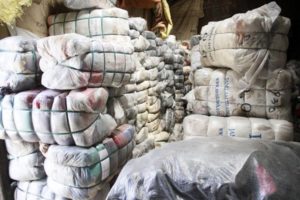After high school,Dominic Odongo visited his brother in Mombasa and helped the sale of the second hand clothes.
He never thought that would transform his life later, he honed his entrepreneurial skills in sales and marketing.
“I then joined campus and during the long holidays I was in Mombasa helping my brother,” Mr Odongo said.

In 2012, while still in his second year at Egerton University, his brother gave him one of the shops so that he could start his own business.
In 2012, while still in his second year at Egerton University, his brother gave him one of the shops so that he could start his own business.

Mr. Odongo says that by saving his two Helb loans which amounted to Sh100,000, he was able to stock the empty shop handed to him by his brother.
“I employed an assistant and I could travel from Nakuru to Mombasa after every two weeks to check the business,” Mr Odongo says adding that he already had customers and his business picked up quickly.

The Analytical Chemistry graduate says that after completing school in 2015, he found no need to tarmac looking for employment.
“From 2016, I decided to give the business my best and since then, i have never regretted,” he says.

The second-hand apparel market is a money-spinner – for everyone involved. Along the import and distribution chain, profit margins more than double as the selling costs dwindle. Anyone who’s in it makes a killing. And there is a huge market for them, too. According to a 2013 Ipsos survey, 62 per cent of middle and lower income urban Kenyans buy mitumba.
The second-hand market has been blamed for the collapse of Kenya’s textile industry. In the 1970s, at its peak, this industry employed 500,000 Kenyans. Now that’s down to 20,000. The business has been overtaken by cheap, trendy second-hand clothes.
The mitumba business is so lucrative that a caucus of traders was dispatched to State House in March this year to appeal to President Uhuru Kenyatta not to shut down the sector.
Nothing has been heard since then of the East African initiative to promote the local textile industry and shut down the second-hand sector.
Where do these clothes come from? They are donations for charities in the US, UK, Australia, and Canada. Well-known global charities like Oxfam, British Heart Foundation and The Salvation Army have bins scattered across these countries where people can drop off used items they no longer wear.
. These items go to charity first. Whatever remains is either resold domestically to thrift stores, or shipped for export to third-world countries. And that’s where we come in.